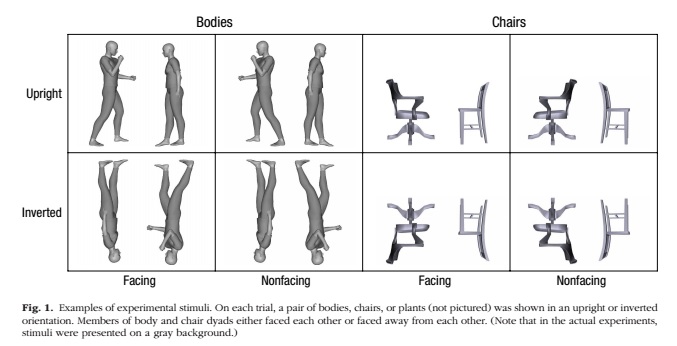The human perception system, designed to process functional groups of people
The research, published in the journal Psychological Science, reveals that the visual system is more efficient at detecting people facing each other, as if they were interacting, than two people standing back-to-back.
Different studies have shown that the human mind analyses visual scenes forming functional groups, a jug pouring water into a glass, for example. So far, this principle had been researched using objects. But how does the visual system deal with a scene in which there are people?

Not all the stimuli that surround us have the same ability to grab our attention. Our visual surveillance system favours the detection of what is most relevant for life, reproduction and individual survival.
In recent years, researchers in the field of cognitive science and neuroscience have found that images of our peers (faces and human bodies) are subject to privileged processing in the brain, so we treat them differently and more efficiently than other objects in our environment. But how do we deal with complex scenes containing multiple actors simultaneously?
Salvador Soto-Faraco, researcher at the Center for Brain and Cognition linked to the Department of Information and Communication Technologies (DTIC) at UPF, together with Liuba Papeo, a collaborator with the centre and member of the Marc Jeannerod Institute of Cognitive Science, and Timo Stein, professor of Psychology at the University of Amsterdam, have developed an approach to measure whether the visual system processes the information of scenes of people interacting in a privileged manner, compared with other objects or images in which people are not interact¡ng.
The results, published in January in the journal Psychological Science, reveal that the processing of groups of people depends on their positioning. The visual system is more efficient at detecting people facing each other, as if they were interacting, than two people standing back-to back, or other objects. That is, it appears that the analysis of a scene with people involves the functional grouping of people.
The results open the way to developing a new way of analysing visual scenes and the selection of relevant parts when in a group situation, in order to determine when it is more likely for a social exchange or an event to take place.
This people-clustering effect is cancelled out if the images are inverted, therefore suggesting that functional groups of people are perceived as a structured unit and can be considered as an initial rudiment of the representation of social actions.
Access of visual information to consciousness involves organizing the complexity of our environment and selects the most relevant parts for us. In addition, the mechanism is sensitive to certain characteristics indicative of functional relationships between elements, such as the position of two people (face-to-face or back-to-back). Therefore, the results of this research suggest that the human perception system is configured to process in a privileged way those stimuli may have a social value and are consequently more relevant for our everyday lives.
